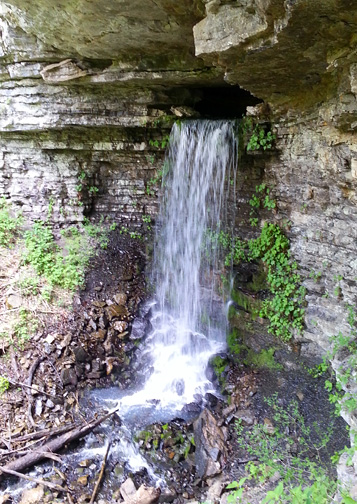 I’ve been exploring the Ozark Mountains of Arkansas since I was 19. There’s no place on earth like it…ancient mountains, thundering waterfalls, pristine rivers, deep and mysterious caves. After after 30 or so trips there, one might start to think that one had explored it all. But recently I became intrigued by an image I found on Google Earth…a photo of a cave with a waterfall pouring out of it. Now, this isn’t an unusual thing in the Ozarks. I’ve photographed and explored a number of caves with waterfalls pouring out of them. But I had never seen nor heard of this one. Moreover, it was in an area of the Ozark National Forest that had NO trails. This was up the Left Fork of Big Creek, a major tributary of the Buffalo National River, near its headwaters. And a bit of intensive internet digging found reference to “Big Creek Cave Falls” and mentioned that OTHER waterfall caves were to be found in the immediate area.
I’ve been exploring the Ozark Mountains of Arkansas since I was 19. There’s no place on earth like it…ancient mountains, thundering waterfalls, pristine rivers, deep and mysterious caves. After after 30 or so trips there, one might start to think that one had explored it all. But recently I became intrigued by an image I found on Google Earth…a photo of a cave with a waterfall pouring out of it. Now, this isn’t an unusual thing in the Ozarks. I’ve photographed and explored a number of caves with waterfalls pouring out of them. But I had never seen nor heard of this one. Moreover, it was in an area of the Ozark National Forest that had NO trails. This was up the Left Fork of Big Creek, a major tributary of the Buffalo National River, near its headwaters. And a bit of intensive internet digging found reference to “Big Creek Cave Falls” and mentioned that OTHER waterfall caves were to be found in the immediate area.
No trails (ie, no people), wild country, caves with waterfalls pouring out of them…you don’t need to ask me twice! So I headed there the very next day.
The few groups who’ve ventured into this area in modern times have been following a bushwhacking route up the west bank of the Left Fork of Big Creek, which is what I did to find the caves. It’s hairy travel, you basically swim through poison ivy and greenbriar for an hour, thrashing your way up the creek. But on the way back, I discovered an old, abandoned logging road on the EAST bank of the creek that whisked me back to my car in 15 minutes. I laughed so hard I almost choked.
To access the trailhead, find the intersection of Arkansas Scenic 7 and Arkansas Highway 16, a few miles north of Nail, AR in the Ozark National Forest. Drive north on Hwy 7 for 1.3 miles, to a small dirt road on the right marked NC6840. (Google Maps and older maps show this road as CR 59.) At first the road looks horrid, just 2 ruts, but give it a few hundred feet…once it passes private property and enters national forest land, it becomes driveable by ANY car. Zero your odometer at the turnoff and take it slow on the road, especially when it starts to plummet STEEPLY downhill. Drive 2.8 miles on dirt road, and you’ll see a single spot on the left side of the road to park, opposite a small dirt road that heads backward at an angle behind you to a locked metal gate. Park in the spot, and head up to the gate. There is an open entrance just to the right. This is national forest land, you are not trespassing. This is an old farmstead. Continue on the old road past the gate through signs of old farming. The road will take you down to the Right Fork of Big Creek, which you’ll have to wade. (I was there in wet season and made it across on stepping stones without getting my feet wet, but YOU MUST BE PREPARED TO GET YOUR FEET WET ON THIS HIKE.) Ford the creek and head up the opposite bank, and you’ll find yourself in a field. Turn left and head into the field past a small line of scraggly trees.
The field opens up to stupendous views. The commonly described route tells you to head uphill and to the right, to the top of the field, where you enter the forest and begin your bushwhack. But you’re smarter than that! Instead, head to the left directly across the field, making for the hill that’s across the Left Fork of Big Creek.
The field is typically overgrown, hiding the old road that crosses it, but as you get close to the tree line on the banks of Left Fork, you’ll find a clear opening where the road emerges and fords the creek:
The Left Fork is bigger than the Right Fork, and you’re gonna get your feet wet fording this one. Once out of the tree line on the other side of the creek, you’ll find yourself in another field. Head straight across it, turn right, and follow the tree line. You’ll go through another small line of trees into yet another field, and at the top of this field, the road emerges again and heads into the forest. Here’s an overview of the area:
Once inside the forest, the old road provides easy, fast hiking up the east bank of Left Fork Big Creek…free of poison ivy and greenbriar:
Soon you’ll come to a dim fork in the road where a rugged spur heads straight ahead and down toward the creek. Take this fork down to the creek and bushwhack downstream a bit to see some pretty waterfalls, giant boulders, and blue pools.
Back at the fork, the main road turns left and heads up to yet another fork and an old cattle guard. The left fork turns back north toward the field. Instead, cross the cattle guard and continue hiking. Soon, you’ll ford a tiny stream coming in from the left. (Up this stream is a neat bluff area with a wet-weather waterfall.) Here the road forks again. The left fork curves around and heads straight uphill. Don’t take that. Instead, head to the right and the road will plunge down to the banks of Wolf Creek, which is what Big Creek is called here in its headwaters. You’re right in the middle of waterfall cave country here.
Ford the creek here (you’re gonna get wet) and you have 2 choices. After fording, the road turns left up Wolf Creek, but instead, you head back downstream on Wolf Creek. In a few minutes, you’ll see a clear stream coming in from your left. This is the spring branch from 2 waterfall caves. Head up the left bank of this stream and quickly you’ll come to a fork in the stream. The right fork heads up to what I’m calling Giant Cave, because it’s really massive. The left fork heads up to Big Creek Cave Falls. First, cross the left fork and head straight up the hill, toward what is obviously a gigantic cave in the bluff. The creek roars out of this huge cave entrance, which is so big I couldn’t photograph it. Inside the massive cave, the left-most passage is where the stream comes from. Explore it to your heart’s content, though you’ll probably get wet!
The passage quickly splits in two, with a higher “dry” level and a lower “wet” level where you’ll find yourself crawling in the stream:
There are other passages in the cave, as well, which you can cross the stream to explore. They will all require crawling, so be warned! The view back out the cave entrance and down the cascading stream is mysteriously beautiful.
When you’ve had enough of Giant Cave, head back out of the cave. You have two options to get over to Big Creek Cave Falls, which is very close by. Scramble back down to where the two cave streams fork, and head right up the other fork. You can immediately climb back up toward the bluff line (or just follow the bluff line directly from Giant Cave) through poison ivy and greenbriar, then follow the bluff line to the left around to Big Creek Cave Falls. The easier route is to follow your instincts (and possibly a bit of flagging tape) up the hill to the LEFT of the stream. The cave entrance will come into view up to your right. There’s a little use trail that goes uphill and curves around, heading up to the left side of the falls, where you can reach the base.
There’s a LOT of water coming out of this narrow cave entrance. And most of it disappears right into the rocks…only a trickle flows in the stream bed down to the join the stream from the other cave. In the inky depths of the cave entrance you can see a chain hanging, indicating someone climbed up there at some point, somehow, to explore. I wonder what they found?
There’s no way to access the cave unless you’re comfortable lead-climbing up overhanging ledges with icy water spitting on you from the falls a few feet away. This is one to sit, ponder, and be stunned by.
When you’re done, head back down the stream all the way to where it joins Wolf Creek to make Big Creek. Turn right and head upstream on Wolf Creek, and soon you’ll be back on that road you were hiking in on. It will peter out on the banks of Wolf Creek below a seemingly-impassable pool and cliff. Listen carefully. You’ll hear a deep roar, like an airplane, from a waterfall that seems to be up on the mountainside across the creek. But that much water would surely be visible as a stream entering Wolf Creek, right?
Wrong.
The biggest waterfall cave of them all is just a few feet from you, but you can’t see it, and you can’t see the water coming out of it because the water goes BACK INTO ANOTHER CAVE and emerges below the small cliff face in front of you to join Wolf Creek. So ford the creek and head up the obvious route just to the left of that cliff. You’ll immediately come to a big stream that disappears into a cave:
Follow the stream uphill and you’ll come to a random yellow gate strung between two trees…but no fence on either side. But the gate is locked, nonetheless. Just head up the stream on the right side of the gate, and soon you’ll be beneath a stunning, roaring falls fanning out from the mouth of yet another massive cave:
This is an important cave. There was a gate (though no fence) and there’s a sign from the Nature Conservancy asking you not to explore the cave. It is home to several species of bats, the most important of which is the highly endangered Indiana Gray Bat. Exploring the cave in winter may wake the bats from their hibernation, causing them to use up their fat reserves and placing them at risk of dying of starvation. Exploring the cave in summer may disturb mother bats from nursing their young, who may fall to the cave floor and die. Spring is the safest time to explore a bat cave because there’s plenty of insects for them to eat outside, and they haven’t given birth to their young yet. But there’s ANOTHER reason not to explore this cave at all.
A mysterious bat disease is sweeping the country, called White Nose Syndrome. It causes white fungus to grow on the nose of the bat, and sores to open up on the bat’s wings. The disease itself doesn’t kill the bat, but it typically wakes the bat up during hibernation, causing it to starve. And why should YOU care about a bat disease?
Because without bats, all humans would starve to death. Our relationship with bats is as important and symbiotic as our relationship with honey bees, that pollinate all the crops that we eat, and that we feed to our meat animals. Bats work on the other side of the equation (though some species are also important pollinators) by eradicating crop pests like grasshoppers. The bat population of a single cave can devour the equivalent of FORTY 18-wheelers full of insects IN A SINGLE NIGHT. From just one cave’s bat population. There’s not enough bug poison in the world to deal with the kind of insect swarms we’d be dealing with if the bats weren’t there to eat them. Organic farming would impossible. And the toxic sprays that would be necessary to keep pests off our crops would pollute our waters, killing many other species, and causing untold human health problems.
So THAT’S why you should care about bats. They’re not evil, they don’t attack humans, they don’t live off human blood, and while they get a bad rap every once in awhile for being potential rabies carriers, dogs are responsible for FAR more animal-human rabies transmissions each year. And besides…they’re super cute!
So the long and short of it is that, without bats, you die, your children die, all human life perishes. So don’t explore this cave beyond its entrance. And click here to find out how you can get involved in the business of helping ensure that we all stay alive by eradicating White Nose Syndrome before it’s too late.
The view out the entrance to the cave made me feel like I was in a tropical jungle, with the roar of the waterfall and the thick green forest all around:
(Again, I’m only a couple of feet back in the stream from the waterfall beneath the overhang of the cliff above the cave, not remotely inside the dark zone of the cave where the bats live. Only the entrance of the cave should be enjoyed.)
If you’re okay with multiple creek crossings, rock climbing, exposure, and very slick rock, Wolf Creek is stunning if you continue upstream. I found this abandoned mine beneath a high bluff just upstream from the cave:
And the creek is heartbreakingly beautiful, with turquoise pools, giant boulders, and the tropical-looking native umbrella magnolia:
When you’re done, get back on the old road, and you’ll be back at your car in 20 minutes…an unbelievably easy, fast access to what is easily one of the most stunning corners of this entire country, much less Arkansas. Here’s an overview of the forest route after leaving the fields, with the traditional bushwhacking route shown in red:
Should you visit the headwaters of Big Creek, please respect this area of great beauty and significance. None of the caves are extensive or particularly beautiful inside…or even particularly explorable, for that matter. (Who wants to crawl in ice cold water?) Which is why I feel it’s okay for me to write about the easy way to access this area. It should be enjoyed and loved and admired by respectful hikers. Its crystalline pools need to be gawked at and swam in. It’s fuzzy inhabitants need to be loved and protected, so we can all continue to have food on our plates. Big Creek is one of the most remarkable places I’ve visited. I’m still on a high from being there…
Feel free to comment below, especially if you have memories of exploring the Ozarks!

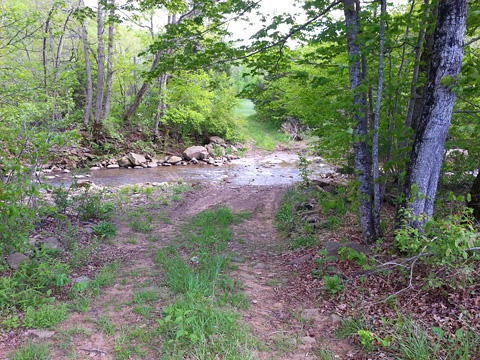
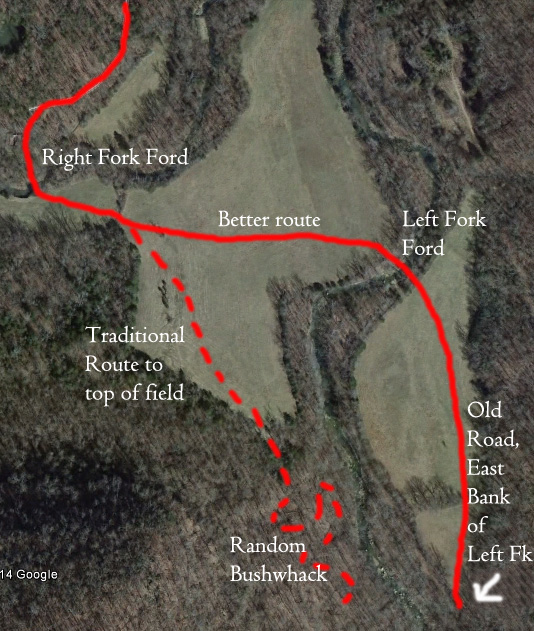
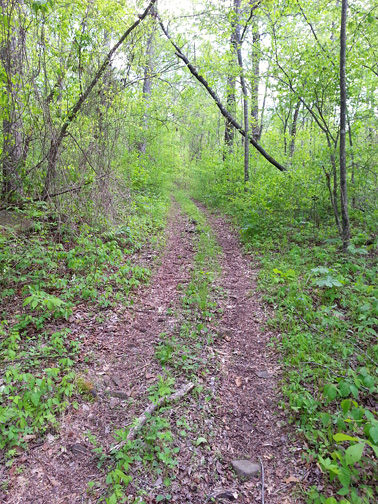
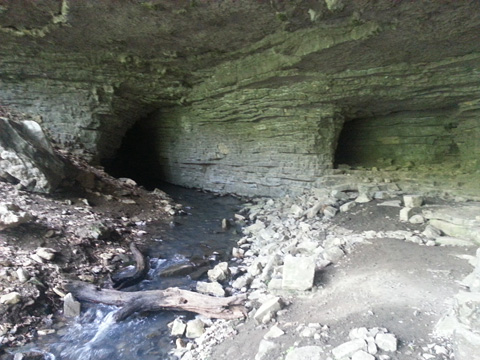
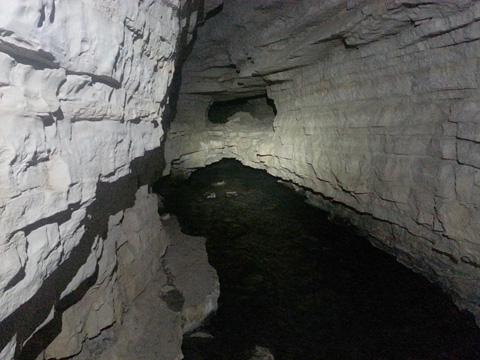
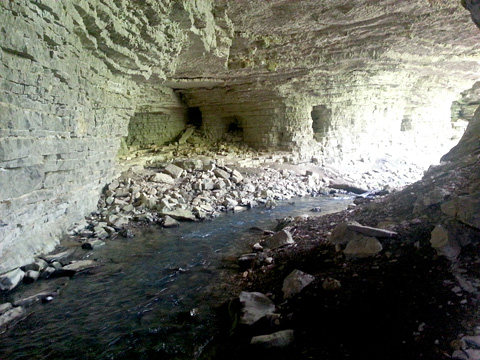
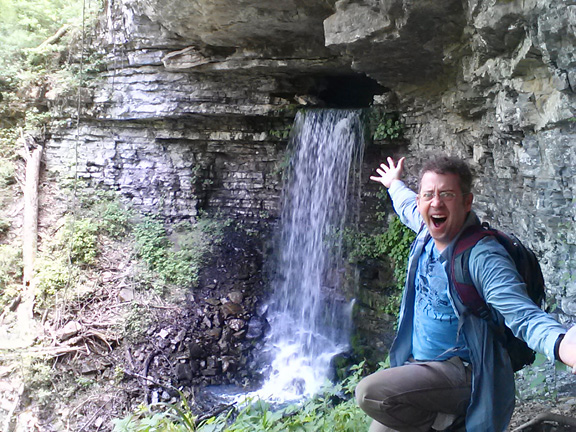
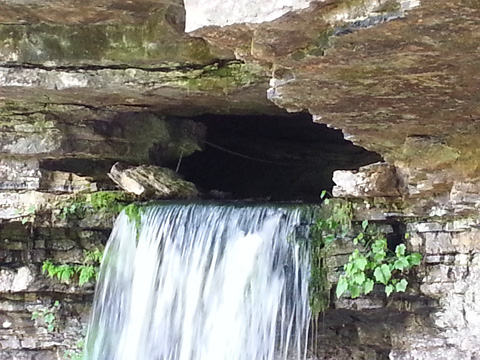
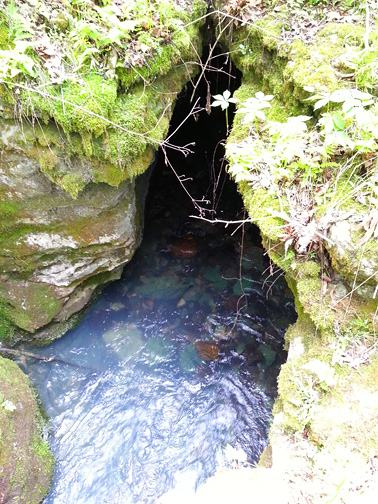
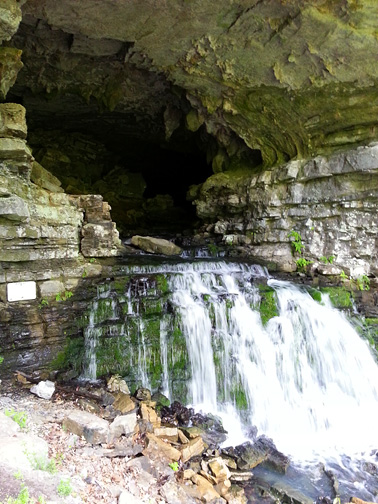

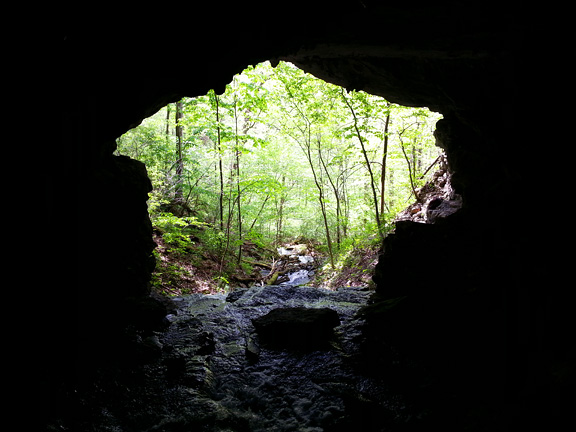
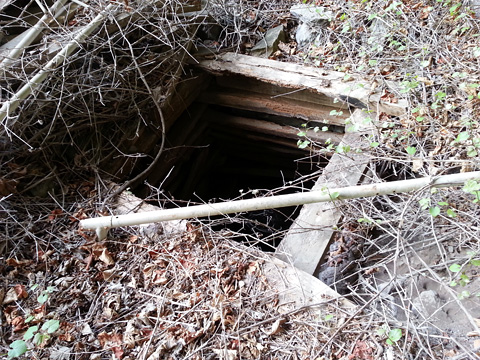
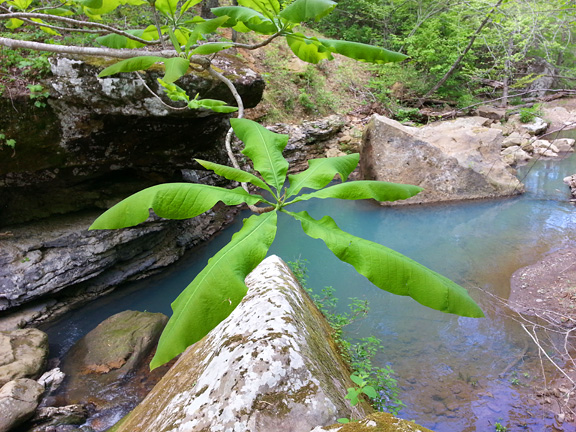
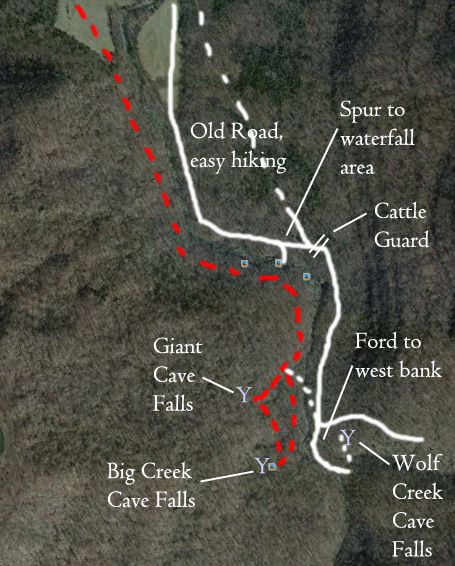
Leave a Reply
You must be logged in to post a comment.